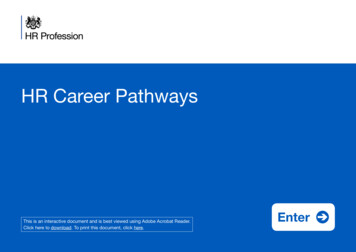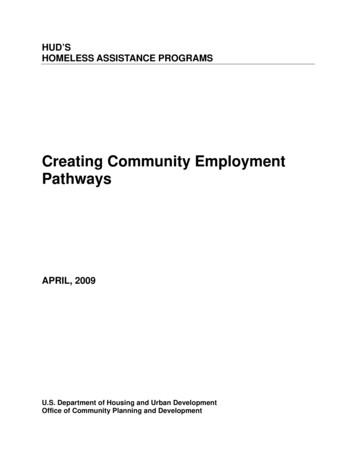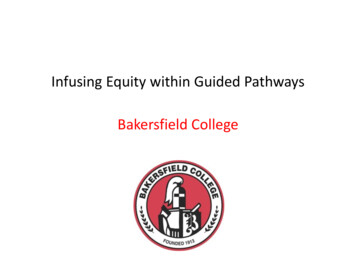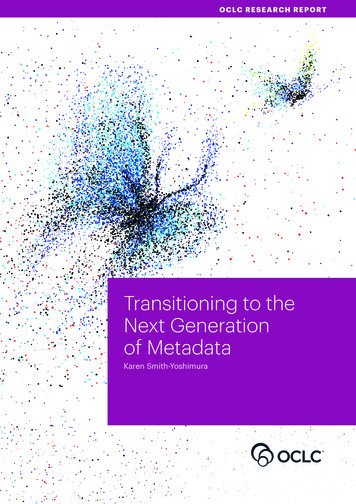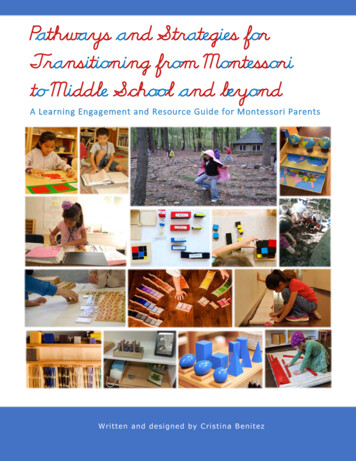
Transcription
Pathways and Strategies forTransitioning from Montessorito Middle School and beyondA Learning Engagement and Resource Guide for Montessori ParentsWritten and designed by Cristina Benitez
About the Author and DesignerCristina Benitez [pronouns: She/her/hers] is pursuing part-time graduate studies in Learning,Design and Technology at Georgetown University’s Graduate School of Arts and Sciences. Hercareer work focuses on the convergence of educational programming and communicationsdesign. She presently serves as an Academic Program Manager at Johns Hopkins University’sSchool of Advanced International Studies. She is interested in the cognitive journey of humandevelopment, human resiliency, and the fostering of creativity and agency in education. She isthe mom of three young scholars who attended a Montessori school in Washington, D.C., fromprimary through 6th grade.2
About this Learning EngagementChange is not always easy. When transitioning between schools that follow different approachesto learning, students must acclimate to different ways of engagement, different ways ofexpression, and different ways of how knowledge may be represented— that gap and challengeof adjusting between different modes of learning is a phenomenon called “educationaldiscontinuity.” When it comes to the transition for Montessori students moving to other types oflearning environments, much of the available research today offers a promising picture of thelong-term learning outcomes. This includes studies by UVA Professor, Dr. Angeline Stoll Lillard,author of “Montessori: The Science Behind the Genius”, whose ground-breaking replicatedstudies and book suggests Montessori students tend to do very well or on par academically totheir non-Montessori peers (Lillard, 2005). But if we focus on the transitional experience itself,particularly during or after Montessori upper elementary (ages 9-12), what are, if any, the mostcommon challenges Montessori students encounter as they get settled into new learningenvironments? What are strategies that have been effective for a smooth transition? This learningengagement is meant to explore these questions. It is designed for Montessori parents but maybe helpful to others as well. It starts with an exploration of foundational concepts of theMontessori philosophy and method of learning. Then, insight is shared from Montessori alumniabout their transitional experience. Through brief readings and media, personal analysis andreflections, parents will create their own family plan to support their child(ren)’s transition afterMontessori. This learning engagement and guide is not meant to provide prescriptive answers,but rather, serve as a starting point; an exercise for exploration and discussion when consideringpathways and strategies for bridging the educational experience from Montessori to newlearning environments.3
Who Should Engage? Parents, guardians and anyone with interest in helping to support the journey of theirstudent(s) from Montessori to middle school and beyond.What You Will Need to Engage: A commitment to reflect and plan for your child’s educational journey. It isrecommended that you engage in all presented activities.Work at your own pace; time needed will depend on your familiarity with key concepts.For action prompts, connect with your chosen person (ie a parenting partner, your child,family member or fellow Montessori parent) for discussion and reflection. Or you maypair up with your person to go through the exercises synchronously together.If working with the printed guide, you will need a pencil and drawing utensils.If working with the digital guide, you will need a notebook, pencil and drawing utensils.Optional: Access to the internet for supplemental online resources, embedded media,activities, and for reviewing peer responses and sharing feedback.How to Engage1. A Learning Engagement and Resource Guide: Reflect, Share and Create.ReflectShareCreate1. Take a moment toreflect.1. Write your responseto prompts.1. Draw your response toprompts.2. Journal yourthoughts.2. Share and discuss.2. Share and discuss.3. Return to note anychanges in yourperspective.3. Return to note anychanges in yourperspective.3. Note lingeringquestions.2. Follow up Coffee & Conversation Meeting. Organize a gathering for further communityreflection. Suggested questions for a group discussion are provided.3. Pay it forward. Build a network of support; reach out to parents of younger Montessoristudents.4
Learning Goals & ObjectivesUpon completion of this learning engagement, you will be able to:1Understand and describe the Montessori philosophy and educational ecosystem. Beingable to explain the Montessori pedagogy will enable you to advocate for your child attheir new school. 2Assess desired virtues and values for character development and educational journey.Determining your family’s desired virtues and values will facilitate deciding what learningenvironment is best for your child. 3Reflect on virtues and values fostered in your child’s current learningenvironment.Consider your child’s learning strengths (gains) and challenges (pains).Consider desired values and virtues for your child’s future learningenvironment.Explore pathways after Montessori (ie schools and colleges attended by Montessorialumni) Engage with a digital map of some schools and colleges attended byMontessori alumni. 4Review core values of the Montessori philosophy and approach.Relate Montessori values to lived and shared experiences.Explore a digital map or list of schools attended by Montessori alumni.Examine school mission statements and note admission requirements.Identify three schools of interest for further investigation.Plan and strategize for your child’s transition. Through reflection and metacognition,consider how you can help facilitate a smooth transition for your child. Consider supports that will be needed for the transition.Design a strategic plan to prepare your child for the admissions process.Create a plan to communicate your child’s strengths and anticipatedchallenges to their current and future teachers.5
Our Work SpacesIn Montessori, children select and may do their work on floor mats that delineate their workspaces. Lessons are presented from left to right and from top to bottom. Inspired by thatsequence and organization, this page represents the contents of this guide as the followingdelineated work spaces for your engagement. Each mat holds the page number and topic.7 A Brief Introto the MontessoriMethod10 MontessoriInfographics –Compare Values12 Glossary ofMontessori terms14 A family Story– The Transitionafter Montessori21 ResearchExecutiveSummary23 ResearchFindings –-CollectiveWisdom32 TransitionalStrategies38 Pathways afterMontessori –a digital map42 Create your ownTransition Plan44 AdditionalResources forParents45 Trivia Time46 Every End is aNew Beginning“We cannot know the consequences ofsuppressing a child’s spontaneity when he is justbeginning to be active. We may even suffocatelife itself. That humanity which is revealed in allits intellectual splendor during the sweet andtender age of childhood should be respectedwith a kind of religious veneration. It is like thesun which appears at dawn or a flower justbeginning to bloom. Education cannot beeffective unless it helps a child to open uphimself to life.”– Dr. Maria Montessori (1909, p. 50)6
“Never help a child with a task at which he feels he can succeed.” – Dr. Montessori, “The Absorbent Mind”A Brief Introto theMontessoriMethod:In this work area (pages 7-11), read and consider the history and core valuesof the Montessori Philosophy and Method. At the end of this section, you willbe asked to take one (1) minute to write your reflections on one (1) of thefollowing prompts: What values of the Montessori Curriculum do you appreciate the most?Is what you appreciate the most different from your child appreciates?Over a hundred and ten years ago, Dr. Maria Montessori proposed thateducators should “follow the child.” She believed that educators (and parents) must “learn from the childhimself the ways and means to his own education, that is, [the educator] will learn from the child how toperfect himself as a teacher” (Montessori, 1909, p. 8). As the first female Italian physician and a scientist,along with advanced studies in pedagogy at the University of Rome, Dr. Montessori’s philosophy andeducational method draws from her knowledge of human development and follows the scientific principleof careful observation. Her fascination and inquiry into the essence of learning was inspired by the workof French physician and educationists Jean Marc Gaspard Itard and Édouard Séguin. Dr. Montessorireferred to her methodology as “scientific pedagogy”; and presented it as a philosophical approach toeducation that aligned with the cognitive, physical, emotional and social arc of human development. Thefirst “Casa dei Bambini” (Children’s House) opened in the San Lorenzo quarter in Rome, Italy in 1907.A deep sense of respect for the dignity and capacities of the young human arecentral tenets of the Montessori philosophy. Dr. Montessori believed that educationwas a “journey” that entailed “discovery” and that through spontaneous action andDiscoverylived experiences, a young human may actualize their natural full potential andexercise their “intrinsic dignity” (ibid, p. 14; 161-163). In her view, the purpose ofeducation was to facilitate the “training and sharpening of the senses” in order toprovide a “solid foundation for intellectual growth” and thereby collectively advance peace and unity (ibidp. 99; 163). In constructing her theories and designing curriculum, she applied physiological lens andcontended that it was essential for “intelligent beings,” to enjoy certain “liberties” in a “prepared learningenvironment” which above all, afforded respect for “the gradual unfolding of a child’s life” (ibid, p. 61).Considering our natural impulse to expand our intellect for purposeful work—Montessori believed thatwhat children needed most from an education was the opportunity to develop their innate capabilities ina “suitable environment where a child can pursue a series of interesting [learning] objectives and thuschannel his random energies into orderly and well-executed actions” (ibid, p. 59; 62;76; 102; 176). Her distinctive approach regards the learner as an ‘explorer’ and therole of the teacher as that of a guide (Montessori called them ‘directresses’) andfacilitator of exploration (ibid). She believed exploration was afforded in education byhaving freedom of expression, freedom of movement, and freedom of choice (ibid).A Journey ofThe intended “liberties” or “freedom” in education are of a veryWhat values areparticular sense. Montessori held that freedoms should bemost importantbounded within an orderly structure. She often clarified in herfor your child’sEducationwork that by “liberty,” she did not mean “countenance to theeducation?external disorderly actions which children left to themselvesengage in as a relief from their aimless activity,” but ratherfreedom to develop their physical, socio-emotional, intellectual selves without environmental restrictionsto their natural curiosity, interests and motivations (ibid). For more on these “freedoms,” review page 10.Autonomy in7
The Montessori pedagogy consists of carefully designed didact materials andscaffolded lessons on a curricular continuum that involves what contemporaryeducational theories today refer to as “recursive-ness” and “excursiveness” (LandCurriculumet al, 2005). She did not believe that education should be homogeneous andcontended that though there should be intentionality in educational design (ibid).Montessori regarded intellectual growth as spanning four “planes of development” she called infancy(age 0 to 6 years old), childhood (age 6 to 12), adolescence (age 12 to 15), and maturity (age 18 to 24).She believed these planes of development included sensitive periods of growth of certain faculties—physical and biological independence during infancy, mental [reasoning] independence duringchildhood, social independence during adolescence, and spiritual and moral independence during theplane of maturity. Within these planes, Montessori believed there were sensitive periods; windows ofopportunities to acquire a specific skill or attribute such as language acquisition. Montessori placedchildren in mixed-aged classrooms; these are called the infant and toddler classroom (0-3 years old),primary (3-6 years old), lower elementary (6 to 9 years old) and upper elementary (9 to 12 years old).Montessori called the curriculum for upper elementary “Cosmic Education”(click to see youtube video)and envisioned it as an introduction to human knowledge and culture through storytelling andexperimentation (Montessori, 1909).The MontessoriThe Montessori prepared learning environment has mixedaged classes with child-size furniture and didactic materialsdesigned to engage learners in exploring “key concepts” thatenvironmentprogress in curricular discovery. Each new concept buildsupon the last and are presented in a three period lessons thatinclude 1) a naming period, 2) recognition and association,and 3) recall. Montessori believed there was a deep connection between the handWhat areas of theand mind and designed materials that presented concrete to abstract concepts andclassroom mostafforded higher and higher level of abstraction (Polk Lillard and Lillard Jensen, 2003,attract your child?p. 64). She recognized children have an insatiable desire for mean-making andWhat areas doessense-making of their world (ibid). Each new lesson affords a child a new choice ofyour child avoid?work. “Homework” is seen as the practical life work of the home. Furthermore,practical life works are presented as having equal value to the disciplines. Thisincludes grace and courtesy lessons meant to advance social peace and order in the classroomcommunity. There are no “exams”; self-correction is integrated in the design of didactic materials. In thisway, the independent action of the child spurs self-evaluation. Further evidence of student learning iscarefully observed by a trained Montessori teacher as the child interleaves their learning through freeselection and execution in a classroom in their learning activities.The preparedThe values and virtues of Montessori’s carefully designedenvironment cannot be understated. From the attributes ofevery sensorial material to mixed-aged learning cohorts tovalues andthe autonomous progression afforded by the curriculum,virtuesevery detail is designed and arranged with intentionality andmeant to draw out the intrinsic motivation of the child (ibid, p.99; 179). Montessori replaced the emphasis on verbal instruction with material thatWhat intrinsicallycontains “within itself its own control of error and thus affords children themotivates youropportunity of teaching themselves by their own efforts” (ibid, p. 319). Her methodchild?places emphasis on the idea that work is construction of self. She found thataffordances such as time to work at one’s own pace builds concentration and fosters a deeper sense ofunderstanding, of one’s own individuality, and respect for others. This in turn fosters a sense ofPedagogical8
community. Montessori regarded education to have a spiritual element that advances peace (ibid, p.320).In her time, Montessori’s ideas were considered radical and received criticism fromsome of her contemporary colleagues including John Dewey. Nonetheless,Montessori’s theories on education greatly influenced later ConstructivistMontessori’seducational theorists including Jean Piaget and Lev Vygotsky (Mooney 2002 p 23).legacyHer research, philosophy, and legacy has impacted the fundamental wayeducators worldwide regard the needs of learners and the importance of aprepared learning environment (ibid). Modern neurological science has confirmed what Montessori couldonly then infer from outward observation: that there is a connection between our hands and our brain; thechild “builds a more efficient brain by eliminating some neural possibilities through inactivation andstrengthening desired neural pathways by repeated usage” (Polk Lillard and Lillard Jensen, 2003, p. 36).Today, her methods are implemented in schools around the world and interest continues to grow(Montessori Public Policy Initiative 2019). Schools receive accreditation by the American MontessoriSociety (AMS) or the Association Montessori Internationale (AMI).MariaDr. Maria Montessori was nominated for the Nobel Peace Prize three times. Montessori alumniinclude Anne Frank, Jacqueline Kennedy Onassis, Nobel Prize-winning novelist Gabriel Garcia Marquez,British Prince William and Prince Harry, and Google founders, Larry Page and Sergey Brin. Alumnus andAmazon CEO, Jeff Bezos, recently announced a 2 billion-dollar initiative to create a network ofMontessori schools in low-income communities (Guernsey 2019). While it is not possible to quantify theimpacts of her educational approach on our world, there are enduring manifestations of the intrinsicmotivation, self-discipline, respect for others, stewardship of the earth and love of learning in the manylives her educational methods have transformed.Watch a video to learn more about Montessori Cosmic Education (2:36 minutes)https://youtu.be/4Tl6o1Vqeas9
Montessori Freedomwithin StructureFreedom of MovementIn Montessori classrooms, mats represent a learner’s workspace. Students are given ‘grace and courtesy’ lessons toinstill respect for each other’s work area and may exercisethe freedom to choose where they work in the classroom—with a rug on the floor, on a table or in designated spacesoutside of the classroom (Montessori, 1909, p. 48, 85). Theteacher’s role is to check that movements are purposeful.Freedom of ExpressionIn a Montessori classroom, students’ voices hold high valueand they are encouraged to express themselves as long asthey are respectful and not harmful to fellow students or theenvironment. A social life full of activity is encouraged as ameans to build community and develop peace and unity.(ibid p. 49; 50)Freedom of ChoiceIn a Montessori classroom, students may exercise freedomof choosing work based on the lessons they have received.A child’s natural interests may drive their selection andinterleaving of concepts and disciplines. Students may alsoselect whether they do the work independently orcollaboratively. When a student is not inclined to work on aparticular discipline area, the teacher’s role is to check andredirect their attention as needed (ibid p. 69; 93; 96-98).Freedom of ExecutionMontessori emphasized children’s freedom to focus on anactivity without interruption from adults and allowed a threehour ‘work cycle.’ Student may exercise freedom to choosetheir work and is progressively guided through curriculumto higher cognitive processes. This schema representsindividual and group level affordances now referred to as‘hacker ethic,’ ‘dynamic enterprise,’ and ‘group flow’ bycontemporary educational theorists (West 2014).Montessori Sensorial MaterialsDr. Montessori believed in a strongconnection between the hand and mind andthat before a new abstract concept ispresented, a learner must first have asensorial understanding of the concept. TheMoveable Alphabet is one of many didacticmaterials she designed for language. It ispresented in primary years (3-5). Letters arefirst presented in cursive by their sound andare color-coded: consonants are red; vowelsare blue. The name of the letter is learnedafter the sounds are mastered. Cursivewriting is presented before print letters giventhey require more fluid motions of the wrist.Reading and writing is presented as flowingfrom left to right and from top to bottom. (ibid,p. 63, 99; 185-241)The Montessori CommunityMontessori designed her classrooms asinteractive learning spaces where individuallearners could work on sense-making andengage in constructing knowledge togetherby selecting, organizing and integrating newconcepts with prior knowledge afterscaffolded lessons that engage theirdifferent senses. In this sense, nts (Moreno et al, 2007). Suchlearning spaces afford the fostering ofcommunity—which is now highly regardedas critical to learning (Oblinger et al, 2006).“One detail that is commonly littleunderstood is the distinction betweenteaching a child how he should act, butleaving him free in the practicalapplication of this freedom, and thatwhich is followed in other systems ofeducation, namely, of imposing the willand power of an adult upon the child andthus guiding him in all his actions.”– Dr. Maria Montessori (1909, p. 93)10
Comparing Pedagogical Frameworks:Montessori and Mainstream School Values & VirtuesAccording to the American Association of Colleges and Universities’ VALUEframework (2019), the purpose of a liberal college education is to prepare studentsfor citizenship and work. If we agree, what virtues need to be developed to bridgeacross educational transitions, to college, to citizenship and to the workforce? InNicomachean Ethics Book II, the philosopher Aristotle defines virtues asexcellences of character acquired through action: “Virtue of character results fromhabit We become just by doing just actions.” Dr. Maria Montessori designed herWhat do you believe ismethod with a similar premise—she believed that through spontaneous action,the purpose ofhumans may actualize their natural social, emotional and cognitive potential andeducation?exercise what she called “intrinsic dignity” (Discovery of the Child, 1909, p. 14;161). The following provides an overview of Montessori values and virtues compared to ‘mainstream’systems of education. Note this list is not intended to be comprehensive—school values vary widelyby pedagogical approach and by type—public, public charter or independent schools may aim fordifferent virtues. Next time you tour a school, inquire what values are a part of their school mission.11
Glossary of the Montessori MethodDefinitions gleamed from text of Lillard, A.S (2005). The Science Behind the Genius. New York: Oxford University PressAbsorbent Mind: The ability and ease with which young children (birth to 6) learn from their environment.Reasoning Mind: The emerging ability of the child in the elementary years to learn through abstractionand imagination.The Control of Error: The intentional design of Montessori materials that makes apparent mistakes made,thereby allowing children to see their own error and correct it themselves.Cosmic Education: Dr. Montessori’s plan and underlying story about the creation of the universe. It ismulti-cultural and interdisciplinary.Cycle of Activity: Periods of concentration on a particular task that should be worked to completion.Didactic Materials: The educational, hands-on materials, which allow for auto-education.Discovery of the Child: Dr. Montessori’s awareness and realization of the young child’s abilities and thespontaneous love of work and learning.Freedom: The child’s free movements and experiences in an environment that provides disciplinethrough liberty and respect for his or her rights.Individual liberty: The value for self-actualization; that the child should have freedom to act on their ownaccord without assistance or limitations determined by the group or environment. That allows for thechild’s own self-construction and what Montessori called “intrinsic dignity of the child” (Montessori, 1909,p. 14).Normalized Child: The child who has adapted to theirMontessori classroom environment and has developed selfdiscipline.Prepared Environment: A learning environment designed tobe peaceful and orderly for enabling the child to be free tolearn through action.Spontaneous Activity: Students learn through action; by doingwork with a variety of materials.Uninterrupted Work: Cycles of uninterrupted work where thechild is able to choose work without interruption and withfreedom to choose their work. This includes completion of thework cycle by putting each material away before choosinganother. This period must be three hours to allow for thedevelopment of habits of mind, including work approach,concentration and understanding.Watch a graphic sketch video – howmany of these concepts and termsare mentioned?https://youtu.be/UzmvtVAuuyI12
One Minute ReflectionWork areas I-II (pages 7-12)Take one minute to write or draw your reflections on one (1) of thefollowing prompts. Then, discuss with your person of choice (aparenting partner, your child, a family member, or a friend). Note anychanges in your perspective.Share What Montessori Method values do you appreciate the most?CreateWhat values do you consider most important for education?You have one minute in a school hallway to explain Montessori education tosomeone unfamiliar with the Method. Go.Write your reflection in this space.Draw an illustration of your thoughts.Optional: Share your reflection online here: https://padlet.com/cristibenitez/s6cfco463ipp13
“The system is partly a memory of its past, just as in origami, the essence of a bird or a horse is both in thenature and order of the folds made. The question that must be answered when faced with a problem of planningor design of a system, is what exactly is a system? It is therefore necessary to know the nature of the innerstructure before plans can be made. – Wolfgang Jonas, “On the Foundations of a Science of the Artificial”A family Story –The transitionafter MontessoriIn work area III (pages 13-17), a family’s story is shared. At the end of thissection, you will be asked to take one minute to write your reflections onone of the following prompts. Why did you initially choose Montessori for your child(ren)? What are your child(ren)’s strengths and educational needs?When our first baby began to crawl, I was compelled to set in motion a protective plan in our hometo keep our baby safe. Anticipating that the sharp edges of our coffee table and that electrical outletsposted dangers to her young curious mind, I was compelled to set in motion a protective plan in ourhome environment to keep our baby safe as she toddled towards physical independence.Preparing for my eldest’s transition to middle school felt no different in urgency as the dayloomed ahead—except in this case, a trip to Home Depot would not result in acquiring the tools andresources I needed. After eight years of being able to drop her off at her Montessori school withouta worry; ensured she would spend a full day of purposeful action in a nurturing learning community,the transition to a new learning environment and an entirely different approach to learning seemeddaunting. There was sadness at arriving at the necessary transition but also for how different herworld was about to become. The transitional worries did not get any easier with my second daughterafter her eight and a half years in Montessori, and I am now back at this same square with myyoungest, my son, after his nine years in Montessori. What I sensed from the first instance and nowanticipating again is what educational theories refer to as ‘educational discontinuity’. Educationaldiscontinuity is what students experience as a result of ideological differences in approach betweentwo different educational systems. After Montessori, there is a need to transition and adopt into anentirely new way of learning.I imagine that someone unfamiliar with Montessori maywonder why go through such a transition three times?Why not transition earlier or perhaps avoid the transitionall together by enrolling our children in a school withmainstream methods of instruction? The answer, at leastfor me, was in the enthusiasm and happiness I observedfrom the very first tour of a Montessori classroom to the excitement in each ofWhy did you initiallychoose Montessori formy children’s voices each day when they shared about their daily work. Theiryour child(ren)?time learning seemed very meaningful to them and because it was so, theywere happily engaged every day. Granted, one exuberantly shared every detail, another preferredto keep their work a mystery, and the other shared depending on the day. Each of my three childrenhave vastly different natural constitutions but as their little personalities blossomed in their early years,it became clear to me that there was something quite amazing about the Montessori method. Theprepared environment and guidance seemed to facilitate the actualization of their full individualphysical, socio-emotional and cognitive potential. That was exciting to observe as a parent. It mademe realize that so much focus is put on education preparing the individual for their future work whentheir current life experience and current work is just as meaningful and important.Why Montessori?14
A leap of faith andMontessori changed my perspective as a parent. It deepened my respect formy children’s voices. I became attuned of their efforts in constructingdiscoverythemselves out of the folds and order in their world. As an educationalapproach that seemed to guide learning in a manner that is aligned with theirdevelopmental needs, and that fulfilled my children’s natural curiosity,Montessori simply felt as the right fit for our family. And so, we took a big leap of faith. We investedin the time and patience the method requires according to each child’s natural tendencies. This“unschooling” was not overnight; it was challenging as a parent to not truly know in a quantifiablesense where our children were in the process of reaching learning objectives. Yet, we werecontinually encouraged by our children’s enthusiasm for learning and by how well their teachers gotto know them as individuals. We did not receive report cards, but the amount of joy they exhibited intheir learning became far more meaningful a measure of how they were engaging as learners. Iimagined
perfect himself as a teacher” (Montessori, 1909, p. 8). As the first female Italian physician and a scientist, along with advanced studies in pedagogy at the University of Rome, Dr. Montessori’s philosophy and educational method draws from her knowledge of human development and



